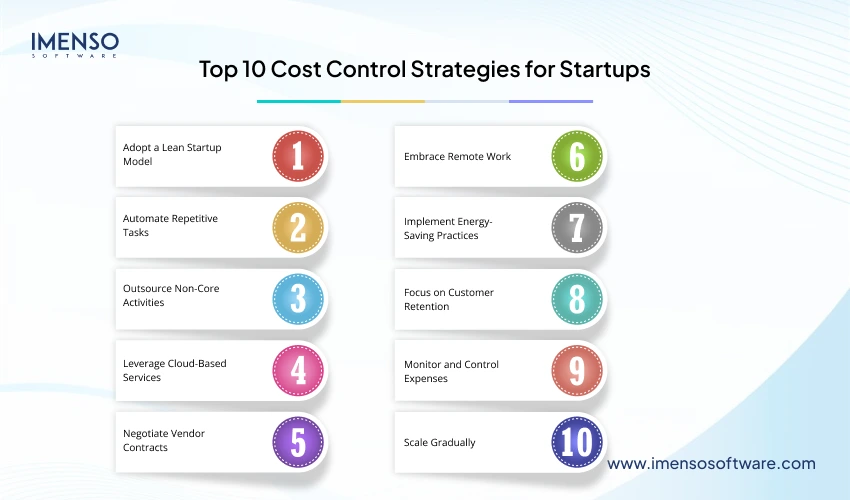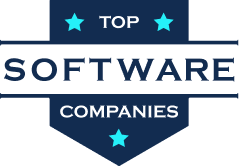Top 10 Cost Control Strategies for Startups

Are you struggling to manage your startup’s finances while still focusing on growth? Cost control is an essential factor in new business since it differentiates between success and failure. According to the study, funding emerges as the leading cause of startup failure among new businesses, with a figure of 28.2%. Nevertheless, this statistic shows the need to embrace practical measures of cost control right from the start in order to facilitate sustainability.
Here in this article, we will reveal the 10 best cost control strategies for startups that every entrepreneur should know. It is a practical guide that points out the efficiency of the process, the elimination of costs that bring no value and the allocation of resources to reinvestment.
Adopt a Lean Startup Model
As pointed out earlier, for a start-up to be most effective, it cannot afford any wastage. The lean startup model is used to avoid the creation of a complete product in the first instance but to launch a minimum viable product MVP to test your idea in the market. This way, all the resources that could have been used in the tests and surveys are reduced to a minimum, while all that is learned from the customer feedback is maximized.
- How it works: Rather than invest in a product with many features that clients may or may not need, develop a product that provides only enough to meet their needs. This means seeking stakeholders’ opinions and then enhancing and extending them a bit at a time.
- Example: A startup intending to create an eCommerce application should first release a platform with basic features to see the demand of the market before expounding on its features.
Why it matters: By using a lean startup model, you get to identify and concentrate on what the customer needs, leaving out irrelevant aspects that may require a lot of funding.
If you are in the eCommerce domain, then you should consider Offshore eCommerce Development Services to get development solutions at cheaper rates from prospective experts.
Automate Repetitive Tasks

Technology can greatly reduce your business’s cost and labour when it comes to marketing, customer relations and accounting services. There are many inexpensive resources to assist startups in meeting this goal.
Automation tools:
- Zapier: Links them to other apps to run activities and improve processes.
- QuickBooks: QuickBooks expedites the accounting and bookkeeping processes.
- Mailchimp: Organizes the company’s email marketing campaigns effectively.
- Benefits: Less paperwork, less prone to mistakes, and greater amount of time to focus on business development.
Pro Tip: Acquire tools to support your business processes. It also means that even slight efficiency increases could yield substantial cumulative cost effects soon enough.
Outsource Non-Core Activities
The problem of having full-time employees in all positions carries the danger of having your overheads shoot up. Rather than this, it is recommended that you outsource all activities that are outside the strategic functions of the enterprise.
- What to outsource: Magazine design services, writing, web development, technical support, and recruitment.
- Benefits of outsourcing: Availability of specialized knowledge, ability to scale up/down and save on expensive permanent staff.
For instance, Offshore e-commerce Development Services can help startups design complicated e-commerce environments. This option affords excellent solutions at a mere fraction of the cost of hiring official developers.
Leverage Cloud-Based Services
Largely, traditional IT infrastructures may take a lot of time and considerable resources to put in place and maintain. The cloud-based solutions introduced in this article provide startup businesses with affordable and growing opportunities.
Popular cloud tools:
- Google Workspace: In the context of stored and installed applications and resources such as email, storage, and collaboration tools.
- AWS (Amazon Web Services): This is for web hosting and other IT-related infrastructure.
- Azure: Of significance, it offers cost-effective and safe cloud technology solutions for start-ups.
- Cost benefits: The pay-as-you-go pricing structure eliminates the issue of large capital investment during the procurement period.
The general idea is that when you switch to the cloud, your IT expenses are lower, though you receive more options and capabilities.
Negotiate Vendor Contracts
When you’re running a startup, every dollar counts. One effective way to reduce expenses is by negotiating better deals with your vendors.
How to negotiate:
- Compare multiple vendors to find the best rates.
- Ask for bulk discounts or longer payment terms.
- Build strong relationships with suppliers for ongoing savings.
- Example: If you are procuring materials to be used in production, buying at lower prices can greatly decrease costs.
Pro Tip: Try to check contracts regularly to be sure they offer the best terms to you.
Embrace Remote Work
The pandemic showed that many businesses can operate effectively without a physical office. Remote work can help startups save on office rent, utilities, and other overhead costs.
Benefits:
- Reduced overhead expenses.
- Access to a global talent pool.
- Improved work-life balance for employees.
Tools for remote work:
- Zoom: For virtual meetings.
- Slack: For team communication.
- Trello: For project management.
These two points are valid – you are able to cut costs by supporting remote work and, at the same time, make your team more flexible.
Implement Energy-Saving Practices
Utilities can be a hidden expense that eats into your budget. By adopting energy-efficient practices, startups can reduce their monthly utility bills.
Energy-saving tips:
- Use LED lights instead of traditional bulbs.
- Turn off equipment when not in use.
- Invest in energy-efficient appliances.
Impact: Reduced energy costs mean that firms can devote more resources to other important areas of development.
Did You Know? They also pay for specific energy-efficient procedures that can enhance your brand image as a sustainable firm.
Also Read:
Creating a Realistic Budget for Your Startup: Best Practices
A Comprehensive Guide to Securing Seed Funding for Your Startup
Conducting Market Research: A Comprehensive Guide for Startups
Focus on Customer Retention
Acquiring new customers can be five times more expensive than retaining existing ones. Focusing on customer retention can significantly reduce marketing and sales costs.
Strategies for retention:
- Offer excellent customer service.
- Implement loyalty programs.
- Use email marketing to keep customers engaged.
Example: The subscription-based startup needs to consider that one effective method to raise its revenue is to provide its clients with a lower price for a prolonged period of contract usage.
Pro Tip: Use customer feedback analysis to learn about the customers’ needs and try to meet those needs.
Monitor and Control Expenses
The ability to manage your expenditure is very important when it comes to minimizing costs. There is nothing wrong with employing tools to keep up to date with your expenses.
Tools for expense tracking:
- Expensify: Rather than managing the expenses that may occur in the course of running a business.
- Wave: A simple accounting solution for small businesses with no cost at all.
- Xero: In this case, the flow can be for the Expense Log, which tracks all the expenses of the business or the project that the business is working on. Invoice Register– This is where details of all the issued invoices are recorded.
- Impact: Consistent checking and tracking make it easier to avoid spending too much so that a good balance is created in resource usage.
Tip: Hold mini-financial audits at least once a month to see where you can cut corners.
Scale Gradually
Rapid scaling can lead to overspending. Instead, focus on growing at a sustainable pace.
How to scale gradually:
- Test new markets before fully entering them.
- Invest in growth only after achieving profitability.
- Avoid over-hiring; only add team members when absolutely necessary.
Example: A startup firm that writes a business plan to develop an eCommerce app can start by concentrating on a local market and expand to the national or international market of their choice.
To learn more about the ways to scale your eCommerce business, you can refer to the following article: A Detailed Guide on Creating an eCommerce App From Scratch.
Being understandable, the level of detail that can be achieved by presenting information helps control costs through technology.
The Role of Technology in Cost Control
These days, everyone needs technology when it comes to cost management. Using the cloud structure and incorporating industrial AI and machine learning, the aspects of the business can be automated and made efficient to control expenses properly.
Let us illustrate this with the example of Microsoft Azure, a cloud solution that helps you gradually build up your startup business. This means that instead of making large upfront investments in physical servers and infrastructural equipment, Azure allows you to store your data and run and grow your applications and business affordably. It will also keep the management of your startup cost-optimal and cost-efficient by adopting technologies that only pay for what you use.
Further, getting access to applications such as business intelligence software helps in the examination of spending and the evaluation of the chances for cost reduction. When you have live tracking on expenditures, you are able to easily focus on the aspects you are spending money on, intending to cut down on such expenses.
Building a Culture of Cost Awareness
When it comes to managing costs effectively, it’s essential that cost-saving tips and cost-control strategies are ingrained in the culture of your startup. This means that all employees, from the CEO to entry-level workers, should be aware of the company’s financial goals and how their actions impact the bottom line.
You can foster a culture of cost awareness by:
- Communicating the importance of cost control to your team regularly, helping them understand how managing expenses contributes to the success of the business.
- Incentivising cost-saving efforts, whether it’s through bonuses, recognition programs, or other rewards for employees who help reduce costs.
- Encouraging suggestions for how to cut unnecessary expenses or streamline operations. In some cases, insiders who work directly with different aspects of the business know better where to reduce expenses.
Controlling expenses
When everyone in the company understands the importance of controlling expenses, the overall organizational performance improves through promoting cost consciousness from the lowest level up to the organizational echelon.
Evaluating the ROI of Your Investments
A fourth concept under this category is probably the most important one, which is the return on investment (ROI) on the costs incurred. Not every cost is the same and it becomes important to question the value each cost brings to the table in terms of business development.
For example, before investing in a new software tool, consider:
- The long-term gains that it will bring in terms of efficiency, productivity and cost reduction.
- The initial investment is needed in relation to the long-term returns that it is likely to offer to its users.
- Others may be cheaper and give similar results as those being proposed.
To that end, by paying particular attention to the ROI of almost all big investment decisions, you can ensure that your startup is making decisions that are best suited for the implementation of such cost-control strategies. It also helps you reduce overheads in low-progressive enterprises in order to fund great reformative projects.
Focus on Lean Methodology
As a result, many startups adopt lean methodology as a means of getting cost-saving tips while making certain that the companies are fast. The primary proposition of the lean method is the article or elimination of the seven wastes and the enhancement of all business activities.
You can apply lean principles to various areas of your business, including:
- Product development: Reduce wastage by thinking of your product development as creating a minimum viable product only. This provides an opportunity to pilot and launch the product to the market on a small scale while incurring a small cost so that you can come up with a product that will be useful in the market.
- Operations: Eliminate all processes and procedures that could be eliminated for the sake of making every process in an organization optimum. To avoid overstretching of available resources, try to use other tools such as project management software to monitor progress and time taken.
- Customer feedback: Perceived benefits: Strive to receive feedback from customers to realize where you can make changes in order to guarantee that your product or service provides what customers need for the price they are willing to pay.
Applying the lean practices means that one is able to provide maximum value for minimum waste.
Conclusion: Sustainability is the key to success for any startup company.
Cost control is not about avoiding or reducing expenses. It is all about being wise and clever when it comes to spending. An understanding of how to efficiently manage startup costs is crucial to ensure that a business gets the most out of its resources and remains on a successful growth trajectory while coding on quality.
But we strongly recommend heading to Clutch to read our clients’ testimonies on how we’ve assisted them in managing costs to achieve their growth aspirations. At Imenso Software, we always aim to make the startups ourselves prosper with solutions that can be efficient in the long run in terms of costs.
Here, you’ll discover what cost control strategies you need to share to make your startup not only survive but also thrive. Welcome to the united team for accomplishing your goal of having a sustainable and profitable startup!
FAQs
What are cost control strategies for startups?
Cost control in a startup is a technique that prevents unnecessary spending and loose cash management and, more importantly, helps a business focus on how to get the most out of its money. These may include issues to do with spending, hiring outside experts, using technology, and re-negotiating contracts.
Why is cost control important for startups?
Controlling cost is an important factor for any start-up to be able to balance their expenses, use their cash wisely and achieve long-term success. Due to sound cost control, startups can reinvest profits into emerging ventures and overcome some financial issues.
How can automation help control startup costs?
Automation decreases the workload on employees and demands less time to complete, yields less error and hence reduces operational cost. Being able to outsource legal issues can save startups time and money so they can concentrate on their core business.
What is the best way to reduce employee costs without cutting jobs?
In order to control the cost of employees, you can work on strategies like allowing flexible working hours, providing a variable wage structure, or acquiring some perquisites like stocks, etc. Outsourcing non-core tasks is also a cost-effective measure.
How do cloud services help with cost control for startups?
This fact enables new-born startups to obtain completely variable infrastructure and software services without purchasing expensive hardware and hiring IT personnel. Public service models reduce costs since consumers only use what they can afford to pay by the go in the event of an emergency.
Want more information about our services?
Similar Posts

How to Adjust Your Budget When Scaling Your Business: Complete Guide
A few years ago, a small company that made software, started thinking why its main product was getting very popular. Obsessed by the growing number of clients, the company began to grow – hire new workers, improve the communication system, and start new ads. Nevertheless, after a few months, the parties proceeded to learn that […]...

Bootstrapping vs. Seeking Venture Capital: What’s Right for Your Startup?
Jeff Bezos, the former CEO of Amazon started the company in his garage with a handful of employees after selling his first book in 1995. Today, the company has grown to be the world’s largest eCommerce store. Mark Zuckerberg launched Facebook from his dorm room while he was in college. Today, Facebook is the world’s […]...

Top Lead Generation Strategies for Startups on a Budget
In 2013, Canva, a small Australian startup was staring down graphic design giants such as Adobe. Their challenge? Not just entering a saturated market, but convincing potential users to even try their platform. Instead of burning through their limited budget on aggressive advertising, they made a bold decision: give their core product away for free. […]...









